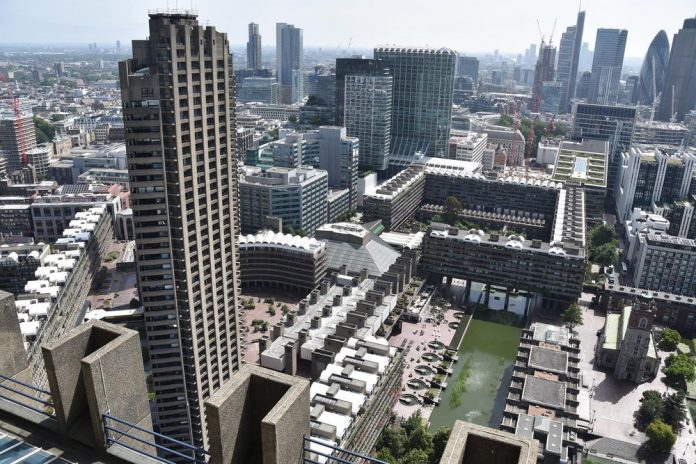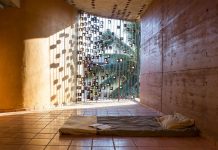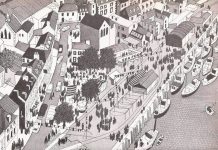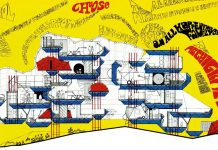Richard Rogers mentioned in a lecture in 1979 that the Centre Georges Pompidou in Paris—the Beaubourg, which had just been completed—is erroneously considered to have been designed by Renzo Piano and himself; it would more appropriate to say that it is “a work of Piano, Rogers and the Fire Brigade.” With this typical British humor, Rogers pointed out that the Fire Department’s requirements decisively influenced the shaping of the building. The most significant change requested was to reduce its height in order to allow rapid evacuation of the upper floors in case of fire. The architects devised an ingenious solution. They submerged the building’s entrance below grade and placed the emergency staircases at its ends so that they exit in the street level. They gave a slightly downward gradient to the large square in front of the building, similar to that of the square in front of Siena’s town hall. The visitors descend toward the building’s entrance effortlessly. The hi-tech façade, with the red escalator, is revealed in all its glory. When the visitors exit, they face people swarming in the square, whose theatricality is pronounced because of its gradient toward the building. Fortunately, cases like this one—when a restriction becomes the cause for good architecture— are not rare.
Beaubourg’s design was adapted to the requirements of ensuring adequate escape routes for visitors, just in case they are needed (hopefully never). Today, safety regulations in almost the entire world prescribe in detail many features of buildings—from the number of classroom exits to the shaping of the handrails on a staircase. Ensuring adequate movement space alone often determines the layout and the configuration of buildings. Let us consider, for example, that Shinjuku Station in Tokyo serves two million passengers on a daily basis—not a novelty of today, though, as architects faced similar problems in the Colosseum or Saint Peter’s Square.
Modern architecture made its goal to serve the general public, not only in the sense of crowd management. It upgraded ordinary people from mere spectators and appraisers of buildings denoting the grandeur of kings or gods, to key players in the formulation of its programs, and its choices in layout and aesthetics.
The conditions for architecture focusing its attention on ordinary people were already formed in the second half of the nineteenth and the first decades of the twentieth centuries. These were firstly political and cultural: the radical labor movement and the demand for more democracy; the metropolis and the anonymity associated with it; the increase of the prestige and power of industry, which by its nature was addressing the needs of the unknown consumer. However, some conditions had to do with architecture proper. As pointed out in Chapter 21, distinct buildings were created to house those activities of urban life that cities considered fundamental for their identity: theaters, museums, libraries. Architecture’s symbolic function was downgraded in favor of its usefulness, even if those buildings connoted by themselves the triumph of the new order over the old regime. Already from the time of their construction, the Gare de l’Est or the Grand Palais brought, mutatis mutandis, a symbolic load much smaller than that carried by Notre-Dame seven centuries earlier. Upgrading usefulness meant that buildings had as primary reference point their users, and secondarily ideology or aesthetics.
Next, building activity focused to an unprecedented extent on the non-privileged. With the end of World War I and the Soviet Revolution, it had become apparent—especially in Europe—that social peace would depend to a significant degree on the improvement of the poor living conditions of the working class. “Even if it cost 100,000,000 [pounds], what was that compared with the stability of the State?” David Lloyd George, the British Prime Minister, wondered in 1919. Affordable housing programs, launched in the eighteen-eighties, increased dramatically.
Architecture was requested to assist this gigantic effort, namely to dramatically broaden its target group. For thousands of years, most people took care of their housing on their own, not resorting to architects. Organized workers settlements, though, designed by experts are recorded from antiquity—among them the settlement built for those working on Sesotris II’s pyramid at Kahun in Egypt. From the mid-nineteenth century, however, designs for simple, practical, and cheap houses for the lower-income strata became increasingly popular. Modern houses for the emerging middle class and the industrial products servicing them were presented at international expositions all over the Western world. Despite being often technologically advanced, these proposals conformed to the then prevailing concept of how a house ought to be: family structure and role distribution within it were considered, as one would expect, as granted; nor were the prevailing habits put into question. The semantic codes associated with the traditional configuration of private houses were not called into question either. Therefore, the form given to the houses of the unprivileged ranged between military barracks of neoclassical aesthetics with some features from Little House on the Prairie and a simplified version of the Renaissance urban mansion—until, practically, the early nineteen-twenties.
In the aftermath of the Great War of 1914–1918 the scale began to tip in favor of the then nascent modernism; modernism challenged conservative architecture in the design of public housing, and made its presence increasingly felt in the periphery of the large European cities, until it faced the hostility of the fascist regimes that swept the continent, Italy being a notable exception. Under its influence, excellent buildings were created even in cases where the presence of Classicism remained vividly distinct. The Karl-Marx-Hof, a complex of monumental dimensions with 1,382 apartments and 1,000 meters long—built between 1927 and 1940 in “red” Vienna based on designs by Karl Ehn—is one of the most famous of this category.
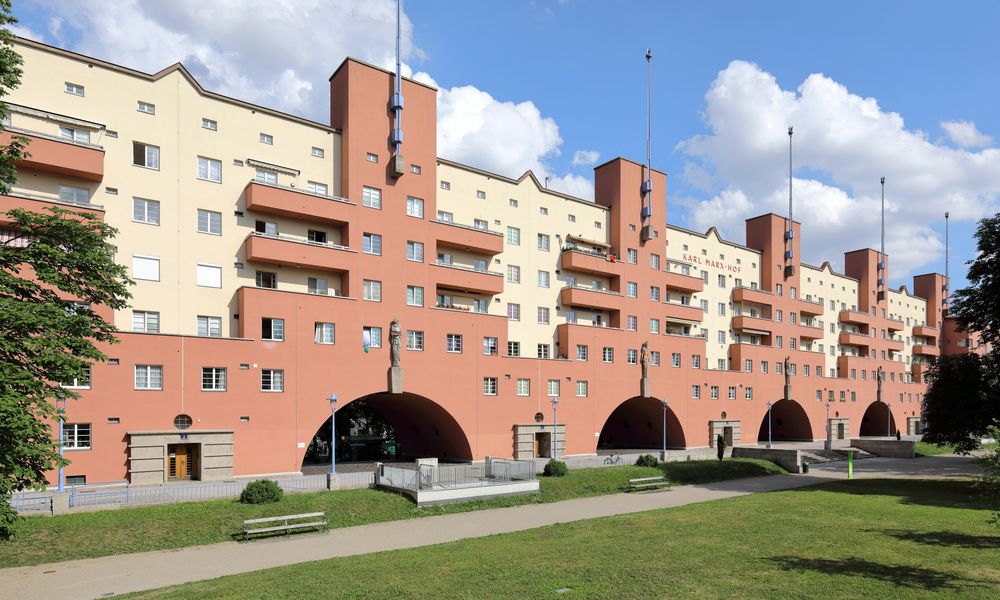
Modernism faced the challenges of the times sometimes with an artistic and technocratic perspective, and sometimes at the basis of a leftist political approach on the role of art and architecture in society.
These two approaches were especially noticeable in the case of Bauhaus—the School founded by Walter Gropius in Weimar, Germany in 1919 to succeed the arts and crafts school of the city and which has contributed more than any other in the reform of artistic and architectural education worldwide. Hannes Meyer, its second director who took over in 1928, upgraded the architecture workshop, founded the previous year, and gave the School a strong leftist orientation. The direction that Bauhaus was taking was opposed by the local authorities in Dessau, where it was relocated in 1925; because they funded it, these authorities had a say on the school’s direction. Ludwig Mies van der Rohe, who replaced Meyer in 1930, reoriented the School to a technocratic approach despite the students’ protests. This was not enough, however, for a Germany that was heading to fascism and turning to a sterilized Classicism for its monumental buildings, and to a neotraditional architecture for residential buildings. Bauhaus was forced to close down permanently in 1933, after a short stay in Berlin.
Functionalism was one of the core doctrines that all modernist architects more or less followed. The buildings had to meet concrete and clearly formulated needs in the simplest way and with optimum means. This was the mission of architecture. To determine the needs it had to fulfill, modernism devised a median human being. It attributed to it certain characteristics—a specific physique and a specific way of thinking—which it attempted to serve in a “Fordist” spirit. Statistics acquired a central role in large-scale design: our familiar methods of presentation with pie charts, tables, graphs and diagrams of the data, now systematically collected, were devised and standards were established. Ernst Neufert’s manual was first published in 1936. In any case, all building projects, even the family hearth, the ark of dreams of ordinary people, could and had to be evaluated in a rational and detached way. The house became “a machine for living in. Baths, sun, hot water, cold water, warmth at will, conservation of food, hygiene…” For many rigid functionalists, especially of the postwar period, nothing more, nothing less. For them, the desires and fears of people who would reside in these buildings should not be taken into account. After all, architecture would change the world and would accomplish this by changing their minds with the new type of houses it professed.
Tiled roofs were considered outdated symbols of an old society and products of the construction technology of the past. Logic imposed flat roofs that could be planted. The dark basements and the thick walls were chains that kept people tied like serfs on their land. Light constructions with thin walls, independent from the load-bearing frame of the building, would set them free.
These ideas found worthy defenders. Walter Benjamin identified dwelling with living in a case, in a secluded and secured area; to him, modern architecture’s destruction of intimacy warranted by the well-protected interior was revolutionary. Transparency and the interaction of exterior and interior spaces would bring traditional dwelling to an end, thus leaving modern man with no choice, but to face the realities of industrial era.
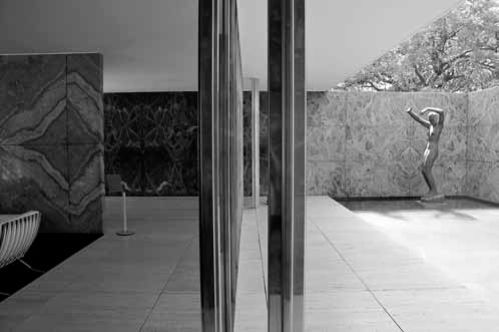
Houses were made eventually transparent; light and air penetrated the secluded areas. However, it is doubtful whether modernism created a completely different habitation culture and led people to a new way of facing the world. Many of its users opposed its missionary obsession to impose on them a specific way of life through the configuration of their houses and took the matter into their own hands. They made changes whenever possible. This is what they did in Pessac, a settlement next to Bordeaux, designed by Le Corbusier in mid-nineteen-twenties for the workers of Henri Frugès’ industries (in 1990 these houses were listed as cultural heritage and were restored to their original form); or manifested antisocial behavior and vandalized private and public properties. Designing houses in an ostensibly positivist spirit does not seem to have had as direct consequence the rationalization of people’s way of thinking. The god of modern architecture, the average person, became its nemesis.
The modernists were anything but a single body and their views varied on some extremely important issues. The architects of the “other modernism” wanted to exploit the expressive power of their art and considered as architecture’s duty the creation of an evocative man-made environment rich in meanings; Alvar Aalto and Hans Scharoun were the most prominent among them; Bruno Taut was the most combative. He was the head of Berlin’s municipal housing service, before being forced to abandon his position and settle in Tokyo and then in Istanbul. Since the late nineteen-thirties, he had distanced himself from mainstream modernism and advocated an earthly positivism: humanistic architecture in the service of its users, who were real people of flesh and blood, children of their time, and not imaginary beings, ideal tenants of ideal residences. His ideas were closer to those later formulated by Theodor Adorno in 1944, in a fierce attack on blatant positivism. Both of them, the former from an architect’s perspective and the latter from that of a socially active philosopher, attacked the notion of the house as a machine.
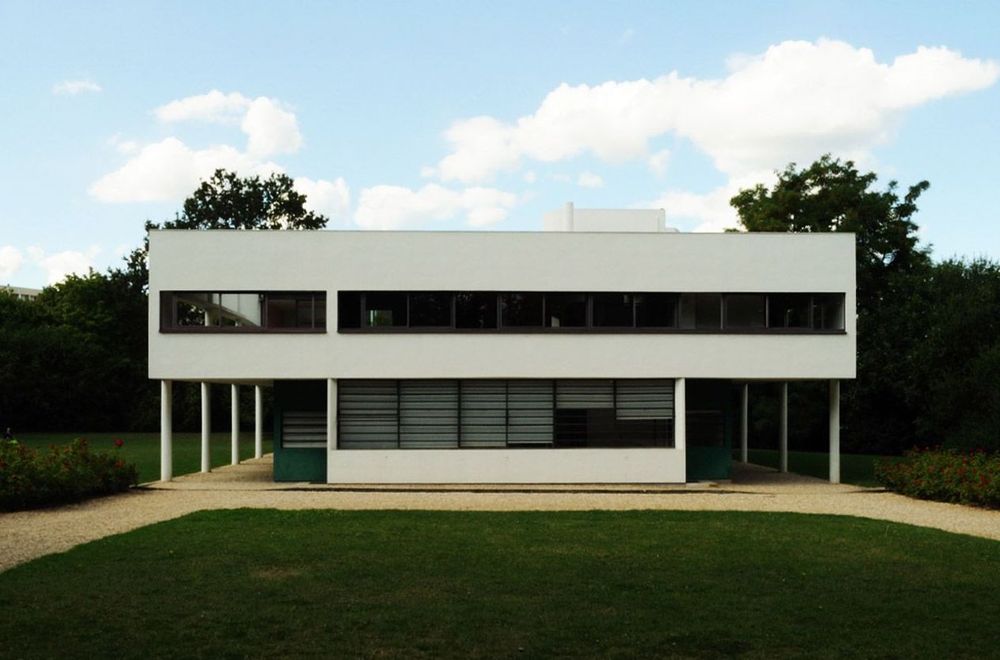
However, as was realized in the following decades, the large windows, the white walls and the functional kitchens were not to blame for people’s alienation from their homes, but instead the destruction of public space outside them. The traditional street of familiar dimensions, which was the vessel of a rich social life, was the victim of the noble cause to let the sun enter every house—something that was not so crucial in the midtwentieth century, as it had been in the mid-nineteenth century. But, as already pointed out, architecture is slow.
In any case, modernism in its prosaic version never really represented the ideas of its founding fathers. The latter were convinced that modern times rendered imperative the radical renewal of forms—the form of cars and books and kitchen utensils and buildings and every other object around us—i.e., the renewal of what we call today visual culture. The basic principle of Bauhaus was that objects had to be designed so that their form makes their function obvious at first glance, and that materials had to be used as effectively as possible and according to their natural attributes. These design principles produced objects of exquisite quality, which withstood the test of time and became classic. This was especially the case for objects in which humans were not involved directly—i.e., those in which the intermediary, largely annoying, link between the creator and his material was largely absent. Tableware and furniture designed by the Bauhaus masters were far less controversial and their forms much more resilient in time than social housing—a vindication for supporters of a more artistic and technocratic approach, and an irony for those wanting a more politically activist role. Technocratic-minded Mies van der Rohe designed the German pavilion for the International Exposition of Barcelona in 1929 as a model residence—perhaps the most important building of modernism. He did this without having to apologize to any tenant for the lack of privacy that he/she probably felt behind the large sliding glass doors, or for the expensive marble walls that made it practically impossible to even hang a painting of one’s choice.
Le Corbusier played two angles at the same time: the certainty of strict positivism on the one hand, and the thrill that art can offer on the other. His aggressive functionalism—the belief that form should result from function—was counterbalanced by his position that architecture lies beyond successful response to the given tasks in the engineer’s spirit of rationality and effectiveness. “Architecture is the learned game, correct and magnificent, of forms assembled in the light,” he stated poetically. Perhaps he had a third angle; having carefully studied advertisement, he used image juxtaposition as a powerful argument that impresses even today’s readers of his immensely influential Vers une Architecture, first published in 1923.
Generally speaking, authorities worldwide were not extremely impressed by modernism. The architecture of the future, as it eventually turned out to be, was an architecture for the marginalized and under-privileged. Modernist public buildings were rather rare, and many of them were erected in the colonies, which became test fields for innovations. From early on, though, modernism offered its services to the members of the upper classes who wanted to be distinguished among their peers for their taste—indeed many iconic buildings of modern architecture are expensive villas. Things changed radically after World War II. Many governments, in an attempt to disengage from images reminiscent of the past, began to adopt modernism; the building of the newly established UN in New York, designed in 1947 by an international committee, with Le Corbusier as its most influential member, marked the beginning of a new era. Large companies also saw the opportunity to break free from the tight grip of the forms of the past—cornices, cornerstones, and Corinthian pilasters. The new visual culture, being recent, was open to appropriation.
Modernism was soon well established. It is difficult to overestimate its impact. If anything, what characterizes the man-made environment today is that the daily life of ordinary people is considered worthy of being imprinted on space more strongly than abstract ideas. Because what else do the vast tracts of commercial and industrial land surrounding the nuclei of our cities denote? They are home to mega-stores and the parked cars in front of them—and to warehouses and industries producing soft drinks, refrigerators, televisions, and software for our PCs. Being substantiated in space the trivial was monumentalized.
From the nineteen-twenties, modernism was dedicated into shaping this new reality. It called for architects not to hide facilities such as supermarkets and gas stations behind columns, epistyles, gabled roofs, and regular geometric solids—i.e., symbolically loaded forms. Moreover, it invented an aesthetics that gave these humble activities the right to appear as what they were. Adoption of Luis Sullivan’s motto “form follows function” helped modernism to justify the forms of buildings it created; first and foremost, though, it helped architecture redefine its very purpose, in order to be allowed to serve ordinary people, to expand its scope, and to exonerate its occupation with ordinary things not expected to last for eternity.
It seems that the most typical recording of this turn of architecture toward the daily life of the common people is the quote of Le Corbusier: “architecture can be found in the telephone and in the Parthenon.” The mere comparison of an ordinary, dispensable, object to a building inhabited by the gods of an exceptional society is almost blasphemous. However, it was characteristic of the new evaluation of things, which was fated to shape the man-made environment and its image for at least one century— perhaps for much longer, time will tell. Furthermore, it gave those practicing this art the impression that they could be considered close associates of Phidias, even if they were designing just one more nice, but trivial, building destined for a limited life span, to be built somewhere in the vast suburban sprawl.

